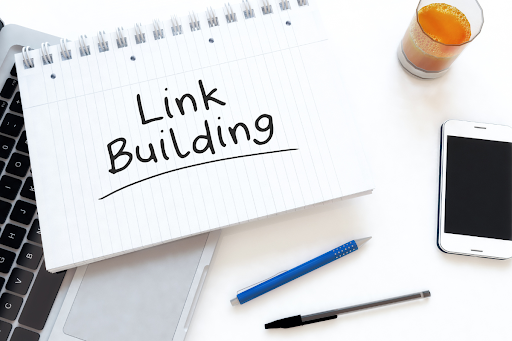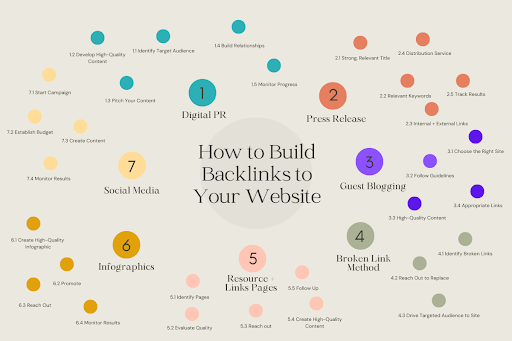Link building is the process of gaining new inbound links (also known as “backlinks”) to a website from other websites. These links act as endorsements for your website, helping to improve its credibility and authority in the eyes of search engines. In turn, this can help to improve your website’s ranking in search results and drive more traffic to your site.
Significance of Link Building Strategies
Search engines use links as a way to understand the relationships between different websites and to determine the credibility and authority of a website. The more high-quality links a website has pointing to it, the more likely it is to rank well in search results.
Links can help to drive targeted traffic to your website. If a website with a relevant audience links to your site, it can bring visitors who are interested in your products or services.
Links can help to establish your brand as an industry leader. If other websites in your industry are linking to your site, it can help to prove your brand as a trusted and respected resource.

Smart Ways to Build Backlinks to Your Website
There are many ways to acquire inbound links, including creating high-quality content that other websites will want to link to, participating in online communities and forums, and reaching out to websites directly to see if you can partner in any way (think sponsorships etc.).
It’s important to note that when it comes to backlinks, the quality of the links is more important than the quantity. It’s better to have a few high-quality backlinks from reputable websites than a large number of low-quality backlinks.
If link building is part of your plan, get serious about Digital PR. You’ll get more inbound links from higher-tier, white-hat type sites, which will give you the highest chance of boosting your search engine rankings.

Invest in Digital PR
Digital PR, or public relations in the digital realm, can be an effective way to get backlinks for your website. It involves creating and distributing content that is relevant, interesting, and valuable to the target audience in order to build relationships, increase brand awareness, and drive traffic and engagement. Digital PR strategies include tactics such as influencer outreach, media relations, content marketing, and search engine optimisation (SEO).
Tips For Using Digital PR To Get Backlinks
- Identify your target audience: Determine which websites and journalists are most likely to be interested in your brand and content and focus your efforts on those outlets. There are tools and software available which can help advise which journalists or brands are regularly talking/posting about the type of content you are publishing.
- Develop high-quality content: Create content that is informative, interesting, and relevant to your target audience. This could include blog posts, infographics, videos, or other forms of media.
- Pitch your content: Reach out to journalists and bloggers with a pitch outlining the value of your content and how it would be relevant to their audience. Include a link to your content in the pitch. Content that includes unique data or research usually has the best chance of gaining attention.
- Build relationships: Building relationships with journalists and bloggers can make it more likely that they will cover your content and link back to your website. This can be done through social media, email outreach, or in-person events.
- Monitor your progress: Use tools like Google Analytics or Google Search Console to track the success of your digital PR efforts and see which tactics are generating the most backlinks.
The goal of digital PR is to enhance the online presence and reputation of a company or individual in order to improve brand recognition, establish credibility, and drive sales or other desired outcomes. By following these steps, you can effectively use digital PR to get backlinks and increase the visibility and authority of your website.
Writing A Press Release For Backlinks
Write and distribute press releases about your business or website and include a link back to your site.
Press releases are a type of written communication that is typically issued to the media to announce news or events. They can be an effective tool for search engine optimisation (SEO) because they provide an opportunity to include keywords and links that can improve a website’s ranking in search engine results.
Tips For Using Press Releases for SEO
- Choose a strong, relevant title: The title of the press release should be attention-grabbing and include the most important keywords for your business or organisation.
- Use relevant keywords throughout the press release: In addition to the title, be sure to include relevant keywords throughout the press release, especially in the first paragraph. This will help search engines understand the content of the press release and improve its chance of ranking in search results.
- Include internal and external links: Press releases can be a good opportunity to include links to your website or other relevant resources. This can help improve the SEO of your website by increasing the number of high-quality links pointing to it.
- Use a press release distribution service: There are many services that elevate your brand’s voice by telling your story and help distribute your press release to a wide audience, including journalists, media outlets, and other industry professionals. This can help increase the visibility of your press release and improve your SEO.
- Track the results: Use analytics tools to track the traffic and engagement generated by your press release. This will help you understand the effectiveness of your press release and identify areas for improvement.
Make The Most of Guest Blogging
Write a blog post on another website in your industry and include a link back to your site in the post.
This is a practice in which a writer creates content for another website or blog, typically with the goal of attracting more traffic or building their own reputation. In guest blogging, the writer creates an article or post that is published on the host website or blog, rather than their own.
Guest blogging can provide a fresh perspective and new content for their readers. It can also help to increase the website’s visibility and reach, as guest bloggers may share the content with their own audience and social media followers. It can also help the writer to drive traffic to their own website or blog, as the host website will often include links back to the writer’s site.
Few Things to Consider When Guest Blogging
- Choose the right website or blog to guest post on: Look for websites or blogs that are relevant to your niche and have a good reputation.
- Follow the guidelines: Most websites and blogs will have guidelines for guest bloggers, including word count, content topics, and submission requirements. Make sure you follow these guidelines to increase your chances of getting your post accepted. Figuring out what type of content the blog has been publishing, and aligning your pitched content with this will provide you with the best opportunity of a ‘yes’.
- Provide high-quality content: The content you create for the host website should be well-written and informative. Make sure it is relevant to the host website’s audience and adds value to their experience.
- Use links appropriately: You can include links to your own website or blog in your guest post, but make sure they are relevant and add value to the content. Don’t overdo it with the links or use them as a way to spam or promote your own site.
Overall, guest blogging can be a great way to build your reputation, reach a new audience, and establish yourself as an expert in your field. Just make sure to follow the guidelines and provide high-quality content that adds value to the host website.
Generate Backlinks with The Broken Link Method
Find broken links on other websites in your industry and reach out to the webmaster to let them know about the broken link and suggest your website as a replacement.
This technique is used in search engine optimisation (SEO) to improve the quality and relevance of a website’s external links. It involves finding and fixing broken links on other websites that point to a specific website or webpage.

Here’s How It Works
First, you need to identify broken links on other websites that are relevant to your business or industry. You can use a tool like Ahrefs or SEMrush to help you find these links.
Once you have identified a broken link, you can reach out to the website owner or editor and let them know about the broken link. You can also offer to provide them with a replacement link that points to a relevant page on your website.
If the website owner or editor agrees to replace the broken link with your link, it will help improve the quality and relevance of your website’s external links. This can have a positive effect on your website’s search engine rankings, as search engines use external links as a ranking factor.
In addition to improving your website’s search engine rankings, broken link building can also drive targeted traffic to your website. When someone clicks on a link to your website from another website, they are more likely to be interested in your products or services.
Overall, broken link building is an effective way to improve the quality and relevance of your website’s external links and drive targeted traffic to your website. It can take some time and effort to find and fix broken links, but the long-term benefits can be well worth it.
Acquiring Backlinks with Resource & Links Pages
Find resource pages on other websites in your industry and suggest your website as a resource that should be included on the page. This strategy is used by website owners and content creators to acquire high-quality backlinks from relevant and authoritative websites.
Implementing A Resource Page Link Building Strategy
- Identify relevant resource pages: Start by finding resource pages that are related to your industry or topic. You can use search queries such as “keyword + resources” or “keyword + link round-up” to find these pages. You can also check out industry blogs and directories to find resource pages.
- Evaluate the quality of the resource pages: Once you have a list of potential resource pages, evaluate their quality. Look for pages with a high domain authority, strong traffic, and a good reputation. Avoid pages with a lot of low-quality links, spammy content or poor user experience (UX).
- Reach out to the page owners: Contact the page owners or editors and let them know about your resource. Provide them with a brief description of your resource and explain how it can be a valuable addition to their page. Be sure to include a link to your resource so they can easily access it.
- Create high-quality content: In order to get your resource included on a resource page, you need to have high-quality content. This could be a blog post, infographic, video, or other type of content that is relevant, informative, and well-written. Make sure to optimise your content for search engines by using relevant keywords and including internal and external links.
- Follow up: After you have submitted your resource, follow up with the page owner or editor to see if they are interested in including it on their page. Be persistent but respectful and be willing to make any necessary revisions to your content if requested.
Resource page link building can be an effective way to acquire high-quality backlinks and drive targeted traffic to your website. However, it is important to approach it in a strategic and ethical manner, as Google may penalise websites that engage in spammy or manipulative link building practices.

Build Links with Infographics
Create an infographic and pitch it to other websites in your industry as a way to provide value to their readers. This strategy is used by businesses and marketers to improve their website’s search engine rankings and drive traffic to their site. This is done by creating an infographic and then promoting it to other websites and blogs in order to get them to link back to the original source.
Using Infographic Link Building as A Part of Your Digital Marketing Strategy
- Create a high-quality infographic: In order to get other websites and blogs to link to your infographic, it needs to be visually appealing and informative. Make sure to spend time on the design and content of your infographic to ensure it meets these criteria.
- Promote your infographic: Once your infographic is complete, the next step is to promote it. This can be done through social media, email marketing, and outreach to other websites and blogs.
- Reach out to websites and blogs: Once you have promoted your infographic, the next step is to reach out to other websites and blogs to see if they would be interested in utilising your infographic in their content. This can be done through email or by using a tool like Buzzsumo to find websites and blogs that have shared similar infographics in the past.
- Monitor your results: After you have promoted your infographic and reached out to other websites and blogs, it’s important to monitor the results of your efforts. Use tools like Google Analytics to track the traffic and link building progress of your infographic.
Infographic link building can be an effective way to drive traffic and improve search engine rankings, but it’s important to create a high-quality infographic and follow best practices when promoting it to other websites and blogs.
Get Active on Social Media
Share your website’s content on social media and include links back to your site. It involves creating and sharing content on social media that is intended to engage and attract customers, and ultimately drive sales.
There are many different social media platforms that businesses can use for marketing, including Facebook, Twitter, Instagram, TikTok, LinkedIn, Pinterest, and more. Each platform has its own unique features and demographics, so it’s important to carefully consider which platforms will be most effective for your business.
How to do Social Media Marketing
- Start a social media campaign: Define your goals and target audience, create a content calendar, and develop a strategy for engaging with your audience.
- Establish campaign budget: Social media advertising can be a cost-effective way to reach a large audience, however it always helps to start off with a budget in mind and then reassess the return on investment before further funding the campaign.
- Create content: Create and share blog posts and articles, share photos and videos, run promotions and contests, and interact with users by responding to comments and messages.
- Monitor and track results: It’s important to track the results of your social media marketing efforts and adjust your strategy as needed to ensure that you’re reaching your goals. Tools like social media analytics and marketing software can help you measure the success of your campaign and identify areas for improvement.
For more information, or if you’d like a backlink strategy for your business from an SEO freelancer, feel free to reach out for a chat via this contact form.

